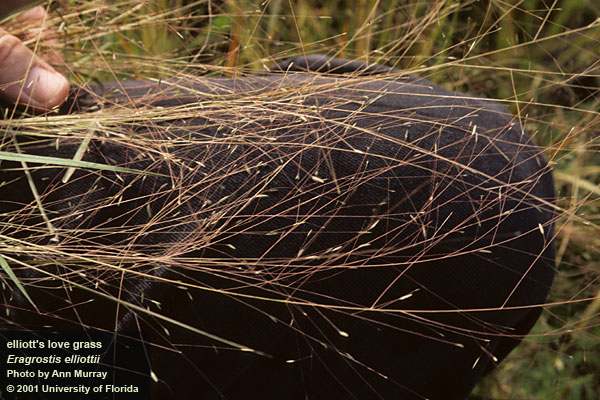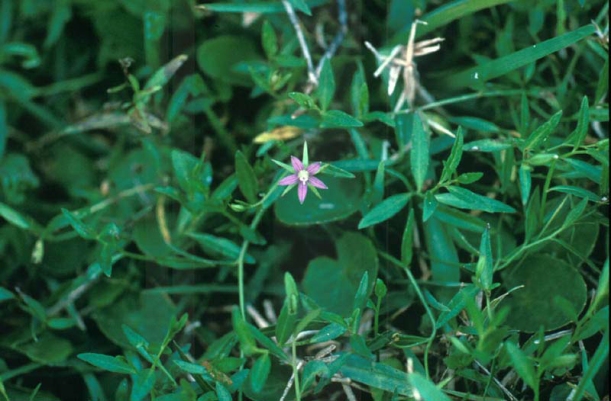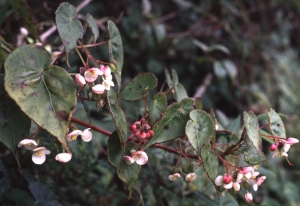 A: Elliot’s Lovegrass, Eragrostis elliottii, is a beautiful native fall blooming grass growing about 2-3 feet tall with the same spread. Elliot’s lovegrass is found among flatwoods, sandhills, and prairies from summer through fall. There are 30 varieties and species of Eragrostis in Florida. The pretty white seed heads bloom late summer to fall and are a good source of food for many local birds. The foliage is green but the flowers are an inflorescent white to tan with a shiny covering which sparkles in the sunlight – I know, I am waxing poetic now! Like so many other ornamental grasses – Elliot’s lovegrass prefers full sun to very light shade and dry, well-drained soil. This will be significant when choosing a planting site as it should not receive irrigation typical of lawngrass. Watering twice a week will kill it. Elliot’s lovegrass is extremely easy to care for and requires little or no maintenance once established.
A: Elliot’s Lovegrass, Eragrostis elliottii, is a beautiful native fall blooming grass growing about 2-3 feet tall with the same spread. Elliot’s lovegrass is found among flatwoods, sandhills, and prairies from summer through fall. There are 30 varieties and species of Eragrostis in Florida. The pretty white seed heads bloom late summer to fall and are a good source of food for many local birds. The foliage is green but the flowers are an inflorescent white to tan with a shiny covering which sparkles in the sunlight – I know, I am waxing poetic now! Like so many other ornamental grasses – Elliot’s lovegrass prefers full sun to very light shade and dry, well-drained soil. This will be significant when choosing a planting site as it should not receive irrigation typical of lawngrass. Watering twice a week will kill it. Elliot’s lovegrass is extremely easy to care for and requires little or no maintenance once established.
Monthly Archives: September 2016
Q: What is the name of this weed I found in my lawn grass?
 A: It looks like Florida Bellflower, Campanula floridana, which is native to Florida. It is a perennial wildflower which makes it more difficult to control as it propagates by rhizomes and seeds. This wildflower can root at each node making it a proficient grower. Florida Bellflower is often found in over irrigated lawns, moist areas or poorly drained soil. It has small purple flowers bloom year round. Florida Bellflower grows up to 12 inches tall and about 6 inches wide; tolerates full sun to partial shade. Typically found in cold hardiness zones 8-10. Best management practice is to reduce water as it cannot tolerate dry areas. Chemical management can be done by applying atrazine in October and March to control seed production. While I know you are not happy with the plant in your lawn, it might not be a bad plant for those areas near retention ponds to help reduce erosion
A: It looks like Florida Bellflower, Campanula floridana, which is native to Florida. It is a perennial wildflower which makes it more difficult to control as it propagates by rhizomes and seeds. This wildflower can root at each node making it a proficient grower. Florida Bellflower is often found in over irrigated lawns, moist areas or poorly drained soil. It has small purple flowers bloom year round. Florida Bellflower grows up to 12 inches tall and about 6 inches wide; tolerates full sun to partial shade. Typically found in cold hardiness zones 8-10. Best management practice is to reduce water as it cannot tolerate dry areas. Chemical management can be done by applying atrazine in October and March to control seed production. While I know you are not happy with the plant in your lawn, it might not be a bad plant for those areas near retention ponds to help reduce erosion
Q: What can you tell me about the Beef Steak begonia?
A: The beef steak begonia, Begonia erythrophylla, is an example of a rhizomatous begonia. This begonia would be better if grown as a house plant as it prefers temperatures well above freezing. If you decide to plant it in the ground, then it would need to be covered with the understanding it may not recover if winter temperatures stay too cold for too long. This particular begonia has a heavy, succulent stem that grows just above the soil surface and sends out adventitious roots. These begonias produce flower stalks of many small flowers well above the foliage. Many different leaf color patterns occur, the leaves have various shapes, leaf margins range from entire to deeply lobed and many have hairy leaves.

